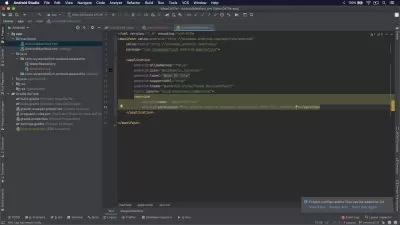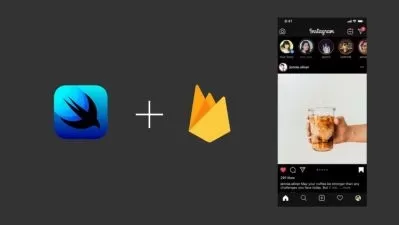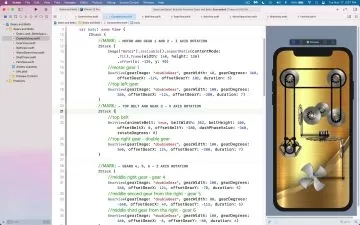Mastering SwiftUI Architecture: Patterns and Best Practices
Mohammad Azam
10:10:25
Description
Elevate Your iOS Development with In-Depth Insights and Practical Strategies for SwiftUI
What You'll Learn?
- Understanding SwiftUI Architecture: Grasp the foundational principles and unique aspects of SwiftUI, differentiating it from traditional UIKit development.
- Limitations of MVVM in SwiftUI: Identify and address the challenges of applying the Model-View-ViewModel pattern in SwiftUI, including state management and comp
- Migrating from MVVM to MV: Learn how to transition from the MVVM pattern to a simpler Model-View (MV) pattern, streamlining your SwiftUI codebase.
- Master techniques for aggregating multiple data sources, managing state efficiently, and implementing aggregate stores in real-world scenarios.
- Create reusable and modular views using SwiftUI's declarative syntax, while ensuring performance optimization.
- Explore various validation patterns and best practices for providing real-time feedback and maintaining scalable validation logic.
- Understand and implement SwiftUI's navigation system, handling both simple and complex navigation flows effectively.
- Learn strategies for integrating UIKit components with SwiftUI, creating hybrid applications that leverage the strengths of both frameworks.
Who is this for?
What You Need to Know?
More details
DescriptionSince its introduction in 2019, the SwiftUI architecture has sparked ongoing debates. Over the past two years, I've dedicated myself to exploring various patterns and best practices aimed at simplifying the development of SwiftUI applications.
I've gained a comprehensive understanding of SwiftUI architecture and how to utilize it in accordance with Apple's guidelines. This course is the culmination of my years of research and hands-on experience. Its aim is to assist you in mastering SwiftUI architecture and embracing best practices throughout your development journey.
Course Overview
In this course, we will cover a wide range of topics crucial for building robust SwiftUI applications. Below is a detailed outline of what you can expect to learn:
Limitations of MVVM in SwiftUI
Model-View-ViewModel (MVVM) is a popular design pattern in iOS development. However, it presents unique challenges when applied to SwiftUI:
- State Management: Managing state across views can become cumbersome.
- Complexity: ViewModels can grow large and complex.
- Performance Issues: Improper state handling can lead to performance bottlenecks.
We will delve into these limitations and explore alternative approaches to streamline your SwiftUI development process.
Migrating from MVVM to MV
SwiftUI encourages a more straightforward approach to architecture, often favoring a Model-View (MV) pattern over MVVM. In this module, you will learn:
- Differences between MVVM and MV: Understanding the core distinctions and when to apply each pattern.
- Migration Strategies: Step-by-step guidance on transitioning your existing MVVM codebase to MV.
- Best Practices: Leveraging MV to simplify your SwiftUI code.
Understanding Aggregate Models/Stores
Aggregating models and stores can significantly improve data management in SwiftUI applications. Key topics include:
- Data Aggregation Techniques: Methods for combining multiple data sources.
- State Management: Efficiently managing state in aggregate models.
- Practical Examples: Implementing aggregate stores in real-world scenarios.
SwiftUI Views
Designing and structuring views effectively is critical in SwiftUI. This section will cover:
- View Composition: Building reusable and modular views.
- Declarative Syntax: Utilizing SwiftUI's declarative syntax to create intuitive and maintainable UIs.
- Performance Optimization: Techniques to ensure your views are performant.
Validation
Input validation is a common requirement in applications. Here, we will explore:
- Validation Patterns: Different approaches to input validation in SwiftUI.
- Real-time Feedback: Providing users with immediate feedback on their input.
- Best Practices: Ensuring validation logic is maintainable and scalable.
Navigation
SwiftUI's navigation system offers unique capabilities and challenges. Topics include:
- NavigationStack: Understanding and using NavigationStack for hierarchical navigation.
- NavigationLinks: Proper usage of NavigationLinks and managing their state.
- Complex Navigation Flows: Handling complex navigation scenarios.
Testing
Testing is essential for ensuring the reliability of your applications. This module will focus on:
- Unit Testing: Writing and running unit tests for your SwiftUI components.
- UI Testing: Automating UI tests to verify user interactions.
- Testing Strategies: Best practices for integrating testing into your development workflow.
UIKit & SwiftUI Interoperability
Many existing projects still rely on UIKit, and interoperability is often required. In this section, you will learn:
- Bridging Techniques: How to integrate UIKit components into SwiftUI and vice versa.
- Hybrid Applications: Strategies for developing hybrid applications that use both frameworks.
- Real-world Examples: Practical examples of interoperability in action.
By the end of this course, you will have a solid understanding of SwiftUI architecture and the skills to implement best practices in your projects. Let's embark on this journey to master SwiftUI together!
Who this course is for:
- Developers with experience in building iOS applications who want to deepen their understanding of SwiftUI architecture and improve their app development skills.
- Individuals who have a basic understanding of SwiftUI and want to learn more about advanced patterns, best practices, and how to effectively structure SwiftUI applications.
- Developers who are comfortable with Swift and have some experience with SwiftUI, looking to enhance their architectural skills and adopt best practices in their projects.
- iOS developers familiar with UIKit who are looking to transition to SwiftUI and understand how to integrate both frameworks within their projects.
- Freelancers working on iOS projects who need to stay current with the latest SwiftUI architectural practices to deliver high-quality applications to their clients.
- Students with a focus on mobile development who wish to gain practical knowledge and skills in SwiftUI architecture, preparing them for professional development roles.
- Passionate programmers and hobbyists who are eager to expand their knowledge of SwiftUI and learn how to build well-structured, maintainable, and scalable iOS applications.
Since its introduction in 2019, the SwiftUI architecture has sparked ongoing debates. Over the past two years, I've dedicated myself to exploring various patterns and best practices aimed at simplifying the development of SwiftUI applications.
I've gained a comprehensive understanding of SwiftUI architecture and how to utilize it in accordance with Apple's guidelines. This course is the culmination of my years of research and hands-on experience. Its aim is to assist you in mastering SwiftUI architecture and embracing best practices throughout your development journey.
Course Overview
In this course, we will cover a wide range of topics crucial for building robust SwiftUI applications. Below is a detailed outline of what you can expect to learn:
Limitations of MVVM in SwiftUI
Model-View-ViewModel (MVVM) is a popular design pattern in iOS development. However, it presents unique challenges when applied to SwiftUI:
- State Management: Managing state across views can become cumbersome.
- Complexity: ViewModels can grow large and complex.
- Performance Issues: Improper state handling can lead to performance bottlenecks.
We will delve into these limitations and explore alternative approaches to streamline your SwiftUI development process.
Migrating from MVVM to MV
SwiftUI encourages a more straightforward approach to architecture, often favoring a Model-View (MV) pattern over MVVM. In this module, you will learn:
- Differences between MVVM and MV: Understanding the core distinctions and when to apply each pattern.
- Migration Strategies: Step-by-step guidance on transitioning your existing MVVM codebase to MV.
- Best Practices: Leveraging MV to simplify your SwiftUI code.
Understanding Aggregate Models/Stores
Aggregating models and stores can significantly improve data management in SwiftUI applications. Key topics include:
- Data Aggregation Techniques: Methods for combining multiple data sources.
- State Management: Efficiently managing state in aggregate models.
- Practical Examples: Implementing aggregate stores in real-world scenarios.
SwiftUI Views
Designing and structuring views effectively is critical in SwiftUI. This section will cover:
- View Composition: Building reusable and modular views.
- Declarative Syntax: Utilizing SwiftUI's declarative syntax to create intuitive and maintainable UIs.
- Performance Optimization: Techniques to ensure your views are performant.
Validation
Input validation is a common requirement in applications. Here, we will explore:
- Validation Patterns: Different approaches to input validation in SwiftUI.
- Real-time Feedback: Providing users with immediate feedback on their input.
- Best Practices: Ensuring validation logic is maintainable and scalable.
Navigation
SwiftUI's navigation system offers unique capabilities and challenges. Topics include:
- NavigationStack: Understanding and using NavigationStack for hierarchical navigation.
- NavigationLinks: Proper usage of NavigationLinks and managing their state.
- Complex Navigation Flows: Handling complex navigation scenarios.
Testing
Testing is essential for ensuring the reliability of your applications. This module will focus on:
- Unit Testing: Writing and running unit tests for your SwiftUI components.
- UI Testing: Automating UI tests to verify user interactions.
- Testing Strategies: Best practices for integrating testing into your development workflow.
UIKit & SwiftUI Interoperability
Many existing projects still rely on UIKit, and interoperability is often required. In this section, you will learn:
- Bridging Techniques: How to integrate UIKit components into SwiftUI and vice versa.
- Hybrid Applications: Strategies for developing hybrid applications that use both frameworks.
- Real-world Examples: Practical examples of interoperability in action.
By the end of this course, you will have a solid understanding of SwiftUI architecture and the skills to implement best practices in your projects. Let's embark on this journey to master SwiftUI together!
Who this course is for:
- Developers with experience in building iOS applications who want to deepen their understanding of SwiftUI architecture and improve their app development skills.
- Individuals who have a basic understanding of SwiftUI and want to learn more about advanced patterns, best practices, and how to effectively structure SwiftUI applications.
- Developers who are comfortable with Swift and have some experience with SwiftUI, looking to enhance their architectural skills and adopt best practices in their projects.
- iOS developers familiar with UIKit who are looking to transition to SwiftUI and understand how to integrate both frameworks within their projects.
- Freelancers working on iOS projects who need to stay current with the latest SwiftUI architectural practices to deliver high-quality applications to their clients.
- Students with a focus on mobile development who wish to gain practical knowledge and skills in SwiftUI architecture, preparing them for professional development roles.
- Passionate programmers and hobbyists who are eager to expand their knowledge of SwiftUI and learn how to build well-structured, maintainable, and scalable iOS applications.
User Reviews
Rating
Mohammad Azam
Instructor's Courses
Udemy
View courses Udemy- language english
- Training sessions 58
- duration 10:10:25
- Release Date 2024/08/11









